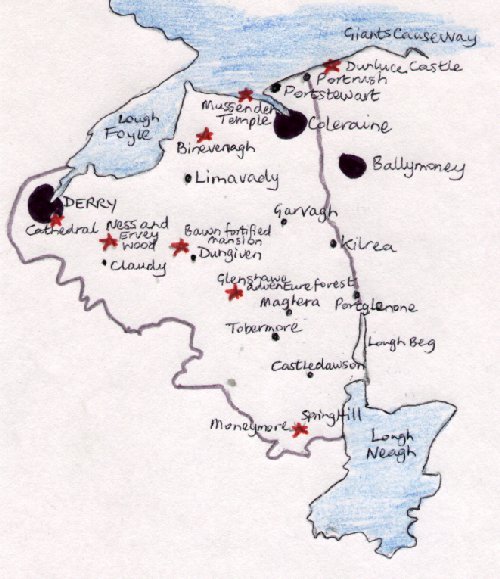|
| Benone Strand
Also known as Magilligan Strand this long sandy beach, 10km (6miles) is Ireland's longest and has earned a Blue flag for cleanliness. At Magilligan Point there is a Martello tower built in the times of the Napoleonic Wars to guard the entrance to Lough Foyle. Coleraine Coleraine is a University town also with a large hospital. the fastest motorcycle race in the world is run between Portstewart , Coleraine and Portrush, during May each year, and is known as the NorthWest 200. Londonderry Londonderry was founded by Saint Columba in 546 AD. He founded a monastery beside the River Foyle, he called the place Doire, meaning "oak grove", later changed to Derry in English. The "London " prefix was acquired in 1613 when the city was selected by the London livery companies as a base of major Plantation. Most people still call it Derry though. St. Columb's Cathedral The cathedral was built in "Planters' Gothic" style. It was the first cathedral to be founded after the Reformation in the British Isles, and was built between 1628 and 1633. The inside was rebuilt in the 19th century. There is a small museum in the Chapter House, which has examples of the locks and keys of the city. There is also a cannonball fired into the city by the troops of James II, with instructions how to surrender hidden in its centre. The reply of the Protestants was "No surrender", a phrase still used by the Loyalists to this day. The Diamond The square in the centre of the city is known as the Diamond. There is a war memorial which was originally meant for the city of Sheffield in England. It was erected in 1927. Earhart Centre Near Derry in 1932 Amelia Earhart landed her small plane ending her record breaking first woman to compleat a transatlantic flight alone. She had intended to fly to Paris, France but ended up landing outside Derry. A sculpture to this American record breaker records the spot, while near Muff there is a centre about her life and achievements. Guildhall The Guildhall was originally built in 1890 but it has suffered a fire in 1908 and a bomb in 1972 which mean that it has been restored recently. There are stained glass windows which tell the history of derry, they are copies of the originals which were lost in the damage the hall sustained. Behind the Guildhall is Derry Quay from where in the 18th and 19th centuries Irish Immigrants sailed to America. Tower Museum O'Doherty Tower where this museum is housed is a replica of the tower that once stood on this site in the 16th century. It houses information and exhibits on the history of the city, and treasures from the Spanish Armada ships that were wrecked off the coast near by. Walls of Derry The walls of Derry are among some of the best preserved city walls in Europe. They rise to 8m (26ft) high, and at places are 9m (30ft) deep. They were finished in 1618 to protect the city from the Gaelic Chieftains in Donegal. the walls were never breached even in a siege in 1689 when out of a population of 20,000 7,000 died from starvation and disease. Just outside the old walls is the butcher's Gate, a famous landmark of the Bogside, a catholic area. Mussenden Temple The temple was built in 1785 by frederick Augustus Hervey, the Protestant Bishop of Derry and Earl of Bristol as a memorial to his cousin Mrs Frideswide Mussenden. It was based on the Temple of Vesta near rome, and is made of basalt and sandstone. It is perched on a headland outside the family resort of Castlerock. It housed a library and it is said a bedroom for the bishop's mistress, the property is now cared for by the National Trust. Items from the bishop's former residence Downhill Castle, which was burned down are now housed in the temple. Portrush Situated on Ramore Head is Portrush. Here is the world famous Royal Portrush Golf Links, and you can walk along the beach to white rocks, where there are arches and caves carved into the limestone by the waves and wind. Portstewart This was a popular victorian seaside town. There is a seafront Promanade, and west of the town is Portstewart Strand a beautiful long sandy beach protected by the National trust. |
